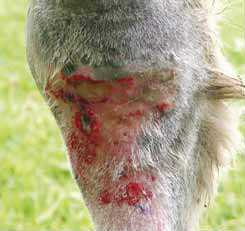Burns - Donkey
| This article has been peer reviewed but is awaiting expert review. If you would like to help with this, please see more information about expert reviewing. |
Definition: a burn is an injury that results from the application of harmful abnormally high (or low) temperatures.

Fortunately burns are rare in donkeys but there are several different types, and each has its own complications:
- Thermal burns
- Scalding
- Friction burns (rope galls or grass grazes)
- Chemical/caustic and exudate ‘burns’
- Freeze ‘burns’
- Actinic sunburn
The face, eyes, breast, back and legs are most often involved as a result of stable or grass fires. While flash burns from explosions usually affect the head, breast and neck, barn or stable fires often result in smoke inhalation that can be at least as serious for the donkey as the most extensive burns.
Burns are described by extent (percentage of body surface) and depth of tissue damage (first, second and third degree).
Rope or focal burns from other causes are simply minor forms of skin necrosis resulting from friction rather than flames. The true extent of the damage may not be apparent immediately and so management must be directed at general supportive measures and focused wound management. Small burns benefit from being covered with a hydrogel immediately and then left to slough. There is no advantage in bursting blisters. Extensive fresh burns should be cooled with cold running water as fast as possible – this is known to limit the severity to some extent. Thereafter hydrogel application and possibly antibacterial creams are advised because burns appear to have an increased tendency to infection.
References
- Knottenbelt, D. (2008) The principles and practice of wound mamagement In Svendsen, E.D., Duncan, J. and Hadrill, D. (2008) The Professional Handbook of the Donkey, 4th edition, Whittet Books, Chapter 9
|
|